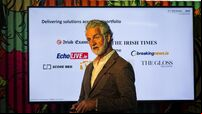Cork Views: Let’s make Cork a bicycle hub

At the same time as we slowly roll out a piecemeal cycling network in Cork, and huff and puff about a single protected cycle lane in Dublin, our European neighbours continue to forge ahead with cycling networks at breakneck speed.
European cities are reaping the benefits in of lower greenhouse gas emissions, reduced air pollution and noise in urban settings, as well as better health for all their citizens - particularly young people who are experiencing greater autonomy and independence as they move more freely around their cities.
Transport was highlighted in the 2025 Climate Action Plan as a problem sector as it remains overwhelmingly dependent on fossil fuels. A fraction (139,412) of the three million cars on the road are electric while the roll-out of public transport and electric charging infrastructure is proceeding at a glacial pace.
Meanwhile, there has been opposition to the construction of a single cycle lane in Sandymount in Dublin, a city that has to date invested in just 34.2km of high quality cycle lanes.
Cork is not much better. Cycling campaigners in Cork highlight how conflict between people cycling and those on foot is being baked into the design of many cycle routes, with ‘the majority of cycle lanes’ now starting and finishing on shared paths which effectively look like footpaths.
Kevin Long, a spokesperson for the Cork Cycling Campaign, highlighted in January the ongoing over-reliance on shared space at city junctions.
Have Irish politicians considered what is happening in much of the rest of Europe in of cycling infrastructure? Have they considered the now mountain of evidence of the benefits of moving from a transport model dominated by fossil fuels to an alternative model that promotes active travel and public transport?
Here are some of the reasons why protected cycle lane infrastructure is the future of urban travel.
Travelling by bike reduces fossil fuel emissions, with each kilometre travelled by bike preventing up to 150g of CO2 emissions. Air pollution is estimated to cause as many deaths per year as traffic accidents. It contributes to lower life expectancy and more respiratory illness.
With no engine, the bike helps to reduce noise pollution, improving quality of life in densely urbanised cities. Mounting evidence has linked urban noise to stress, sleep disorders, hearing loss, poor mental health, cognition problems including memory impairment and attention deficits and low birth weight. Noise even has an impact while we sleep, leading to a raised heart rate in a noisy traffic- fuelled environment.
The bicycle is one of the most affordable options for daily transport. It requires no fuel or recurring parking fees, tax or insurance. Servicing fees are a fraction of those for a car. On average, the annual cost of maintaining a bike is 10 times less than that of a car.
During rush hour, bicycles are faster than other modes of transport for short distances. They allow you to avoid traffic jams and move more freely thanks to alternative routes and cycle lanes.
Urban cycling strengthens community cohesion by facilitating interaction among citizens. It allows you to stay more connected to your surroundings and the people around you, creating a more collaborative and friendly atmosphere. Contrast this with the frequent unpleasant interactions between drivers, each in their own self-contained pods.
The evidence repeatedly shows more bikes and less cars can benefit businesses, as cyclists tend to shop more often in retail outlets. Shops, cafés, and markets are often the biggest beneficiaries, reinforcing local economies and providing a welcome economic boost to retail outlets, restaurants and cafés in city centres.
While Ireland lags behind, cities across Europe are paving the way towards more sustainable mobility and a greener much healthier future.
Amsterdam, the world capital of cycling, has an extensive network of over 500km of bike lanes; 38% of trips are made by bicycle due mainly to infrastructure specifically designed for cyclists and a culture that prioritises sustainable mobility. It is estimated that the widespread use of bicycles saves citizens over €19 million in transport costs.
Paris has had a cycling revolution, driven by the vision and political will of its Mayor, Anne Hidalgo. It has added more than 1,000km of bike lanes, including protected paths on the Champs-Élysées and the closure of streets to traffic in favour of cyclists and pedestrians. By 2026, Paris aims to be a completely cyclable city, with a budget of €250 million dedicated to cycling infrastructure.
Berlin took advantage of the covid pandemic to push out sustainable mobility in the city, adding 25 m of temporary bike lanes that later became permanent due to their success.
Moving whole cities away from cars to bikes has not been without its challenges. Top of the list is the need for well-connected and safe cycling infrastructure. Until this is in place, many potential cyclists are discouraged from taking it up. There can be conflicts between cyclists as well as between cyclists and drivers, as have been highlighted in Cork. However, well designed infrastructure has the potential to keep these to a minimum.
Cities with extreme weather or challenging terrain face additional barriers – electric bikes can help to overcome these obstacles.
But by far the biggest challenge is cultural resistance. In major Irish cities including Cork, Dublin, Galway and Limerick, where cars remain the dominant mode of transport, the magnitude of this resistance is very apparent - as exemplified by the recent outrage over plans to install a single protected cycle lane in our capital city and the sparsity of cycle paths on main roads in Cork city.
Changing these habits requires awareness campaigns and policies to incentivise cycling. As important is the need for a solid vision of a city centred on sustainable mobility and the political drive and determination to make that vision a reality.
Dr Catherine Conlon is a public health doctor in Cork.







 App?
App?




